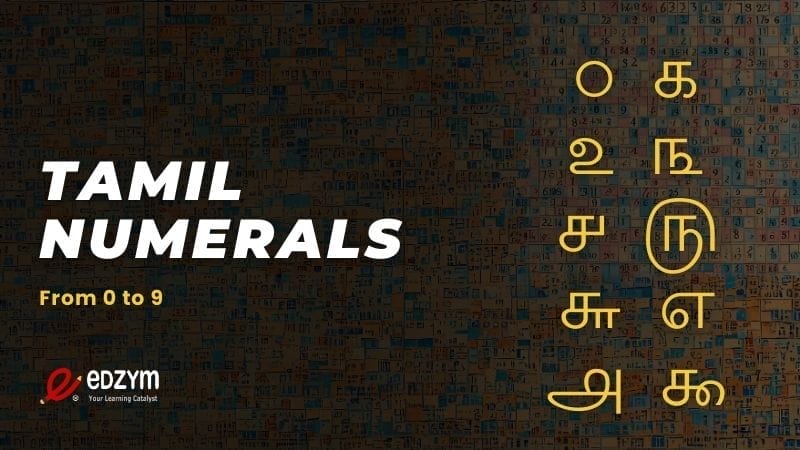Understanding Tamil Numbers: Learn from 1 to 20 and Beyond
Tamil is one of the oldest languages in the world, with a rich history and a vibrant culture. Among its many unique features are its numbers, which are an essential part of everyday life in Tamil-speaking regions. Learning Tamil numbers not only helps in understanding the language better but also connects you with a significant aspect of Tamil culture and traditions.
In this guide, we’ll explore the basics of Tamil numbers, starting from 1 up to 100. Whether you’re a language enthusiast, a traveler, or a student, this article will provide you with a clear and easy-to-follow introduction to Tamil numbers. By the end, you’ll have a solid foundation to help you count, calculate, and appreciate Tamil in your daily interactions.
The Basics of Tamil Numbers
Tamil numbers are part of a unique numeric system that has been used for centuries in Tamil-speaking regions, primarily in Tamil Nadu (India) and Sri Lanka. Unlike some other number systems that use Arabic numerals, Tamil numbers have their own distinct symbols and pronunciations.
Tamil Numerals Table
| Number | Tamil Numeral | Transliteration | Tamil |
|---|---|---|---|
| 0 | ௦ | Poojyam | பூஜ்யம் |
| 1 | ௧ | Onru | ஒன்று |
| 2 | ௨ | Irandu | இரண்டு |
| 3 | ௩ | Moondru | மூன்று |
| 4 | ௪ | Naangu | நான்கு |
| 5 | ௫ | Aindhu | ஐந்து |
| 6 | ௬ | Aaru | ஆறு |
| 7 | ௭ | Ezhul | எழு |
| 8 | ௮ | Ettu | எட்டு |
| 9 | ௯ | Onpathu | ஒன்பது |
What Are Tamil Numbers?
Tamil numbers are used to represent quantities and perform calculations in the Tamil language. They are an integral part of daily life, appearing in everything from street signs and menus to official documents and educational materials. Learning Tamil numbers allows you to interact more effectively in Tamil-speaking environments and gain a deeper appreciation of Tamil culture.
A Quick Look at the Tamil Numeric System
The Tamil numeric system is quite straightforward and follows a pattern that is easy to grasp once you get the hang of it. Tamil numbers are divided into units (1 to 10), teens (11 to 20), and so on, similar to other numbering systems. Understanding the basics will help you recognize patterns and construct larger numbers.

Tamil Numbers from 1 to 10
Learning the Tamil numbers from 1 to 10 is a great starting point. These basic numbers form the foundation for counting and constructing more complex numbers. Here’s a simple guide to Tamil numbers from 1 to 10:
| Number | Tamil Numeral | Transliteration | Tamil |
|---|---|---|---|
| 1 | ௧ | Onru | ஒன்று |
| 2 | ௨ | Irandu | இரண்டு |
| 3 | ௩ | Moondru | மூன்று |
| 4 | ௪ | Naangu | நான்கு |
| 5 | ௫ | Aindhu | ஐந்து |
| 6 | ௬ | Aaru | ஆறு |
| 7 | ௭ | Ezhul | எழு |
| 8 | ௮ | Ettu | எட்டு |
| 9 | ௯ | Onpathu | ஒன்பது |
| 10 | ௧௦ | Pathu | பத்து |
Understanding Tamil letters and basic Tamil words can indeed help in learning Tamil numbers with greater fluency.
Tamil Numbers from 11 to 20
Once you’re comfortable with the numbers from 1 to 10, it’s important to learn the numbers from 11 to 20. These numbers build on the basics and introduce new patterns in Tamil. Here’s a guide to numbers from 11 to 20, along with their transliterations/pronunciations and Tamil numerals:
| Number | Tamil Numeral | Transliteration | Tamil |
|---|---|---|---|
| 11 | ௧௧ | Pathinonru | பதினொன்று |
| 12 | ௧௨ | Pathinirandu | பதினிரண்டு |
| 13 | ௧௩ | Pathinmoondru | பதின்மூன்று |
| 14 | ௧௪ | Pathinaangu | பதினான்கு |
| 15 | ௧௫ | Pathinaindhu | பதினைந்து |
| 16 | ௧௬ | Pathinaaru | பதினாறு |
| 17 | ௧௭ | Pathinezhul | பதினேழு |
| 18 | ௧௮ | Pathinettu | பதினெட்டு |
| 19 | ௧௯ | Pathinonpathu | பதினொன்பது |
| 20 | ௨௦ | Irupathu | இருபது |
Patterns and Formation
- 11 to 19: The pattern is relatively simple. To form these numbers, combine the base number (10) with the numbers 1 through 9. For instance, 11 is Pathinonru (பதினொன்று), which is essentially “10 + 1”.
- 20: The number 20 is Irupathu (இருபது). Unlike the numbers from 11 to 19, which are variations on the number 10, 20 introduces a new base for higher numbers.
Understanding these patterns helps in constructing even larger numbers as you continue learning Tamil numerals.
Key Patterns and Rules
Once you’re familiar with the numbers from 1 to 20, you’ll find that Tamil numbers follow a logical pattern that makes it easier to understand larger numbers. Here’s a guide to help you grasp the patterns and rules for forming Tamil numbers beyond 20:
Patterns for Numbers Beyond 20
- Tens Place (21-29, 31-39, etc.)
- Tamil numbers in the tens place follow a straightforward pattern. For example:
- 21: இருபத்தி ஒன்று (Irupathi Onru) – “20 and 1”
- 22: இருபத்தி இரண்டு (Irupathi Irandu) – “20 and 2”
- The pattern is “Base number (20, 30, 40, etc.) + [Unit Number]”. Here, Irupathi (இருபத்து) means “20” and is combined with the unit number.
- Tamil numbers in the tens place follow a straightforward pattern. For example:
- Thirty to Ninety
- Tamil numbers from 30 onwards use the base number combined with units:
- 30: முப்பது (Muppathu) – “30”
- 45: நாற்பது ஐந்து (Naappathu Aindhu) – “40 and 5”
- Similarly, you combine the base number (30, 40, 50, etc.) with the unit numbers (1-9) to form numbers.
- Tamil numbers from 30 onwards use the base number combined with units:
Hundreds and Thousands
- Hundreds
- For hundreds, you use the word நூறு (Nooru) for 100, and then combine:
- 100: நூறு (Nooru)
- 200: இருநூறு (Iru Nooru) – “200”
- 350: மூவாயிரம் ஐந்து (Muvayiram Aindhu) – “300 and 50”
- For hundreds, you use the word நூறு (Nooru) for 100, and then combine:
- Thousands
- Tamil numerals also include larger units like thousands:
- 1000: ஆயிரம் (Aayiram)
- 2000: இரண்டு ஆயிரம் (Irandu Aayiram) – “2000”
- 5000: ஐந்து ஆயிரம் (Aindhu Aayiram) – “5000”
- Tamil numerals also include larger units like thousands:
Note: In Tamil, மூவாயிரம் (Muvayiram) means “3000”. For 350, you should use மூன்று நூறு ஐந்து (Moondru Nooru Aindhu).
Examples of Larger Numbers
- 123: ஒருநூறு இருபத்து மூன்று (Oru Nooru Irupathi Moondru) – “100 + 20 + 3”
- 789: Seven hundred and eighty-nine: எழு நூறு எண்பத்து ஒன்பது (Ezhhu Nooru Enpathu Onpathu) – “700 + 80 + 9”
Understanding these patterns and rules will make learning Tamil numbers beyond 20 much easier and more intuitive. Keep practicing, and soon you’ll find yourself comfortably using numbers in Tamil in a variety of contexts.
Tips for Practice
- Practice Counting: Start by practicing numbers in increments (10, 20, 30, etc.) and then add units.
- Use Real-Life Examples: Read prices, dates, and addresses in Tamil to reinforce your understanding. Practical application of numbers in everyday situations will enhance your learning and it is worthy to note that you can learn Tamil through English.
- Write and Speak: Practice writing and saying numbers aloud to build familiarity.
- Consider Personalized Tamil Classes: To further enhance your skills and receive tailored guidance, consider enrolling in one-on-one personalized Tamil classes with native Tamil tutors. These classes provide an opportunity to practice Tamil numbers and other aspects of the language in a supportive and interactive environment. Native tutors can offer real-time feedback, address specific questions, and help you improve your pronunciation and comprehension.
Conclusion
Learning Tamil numbers opens up a new dimension of understanding the language and culture. By familiarizing yourself with the numbers and practicing regularly, you’ll gain confidence in using Tamil in various contexts. Remember, the key to mastering any language skill is consistent practice and engagement.
If you’re looking for personalized assistance, our one-on-one Tamil course with native tutors can provide you with the support you need to excel. Book a free demo session today to experience how personalized instruction can make learning Tamil numbers and the language itself more effective and enjoyable.









